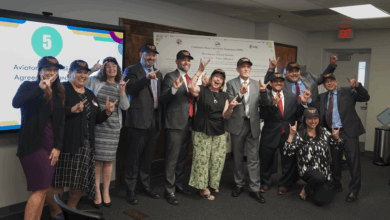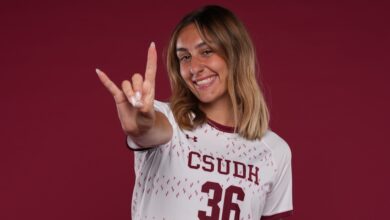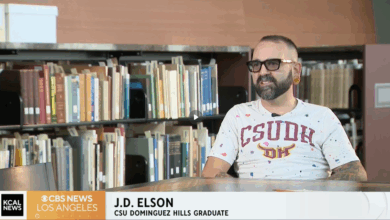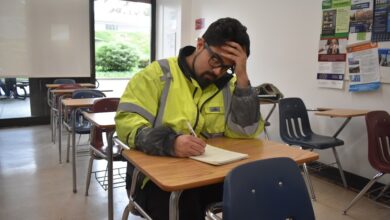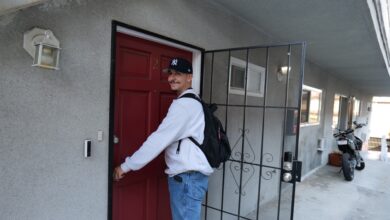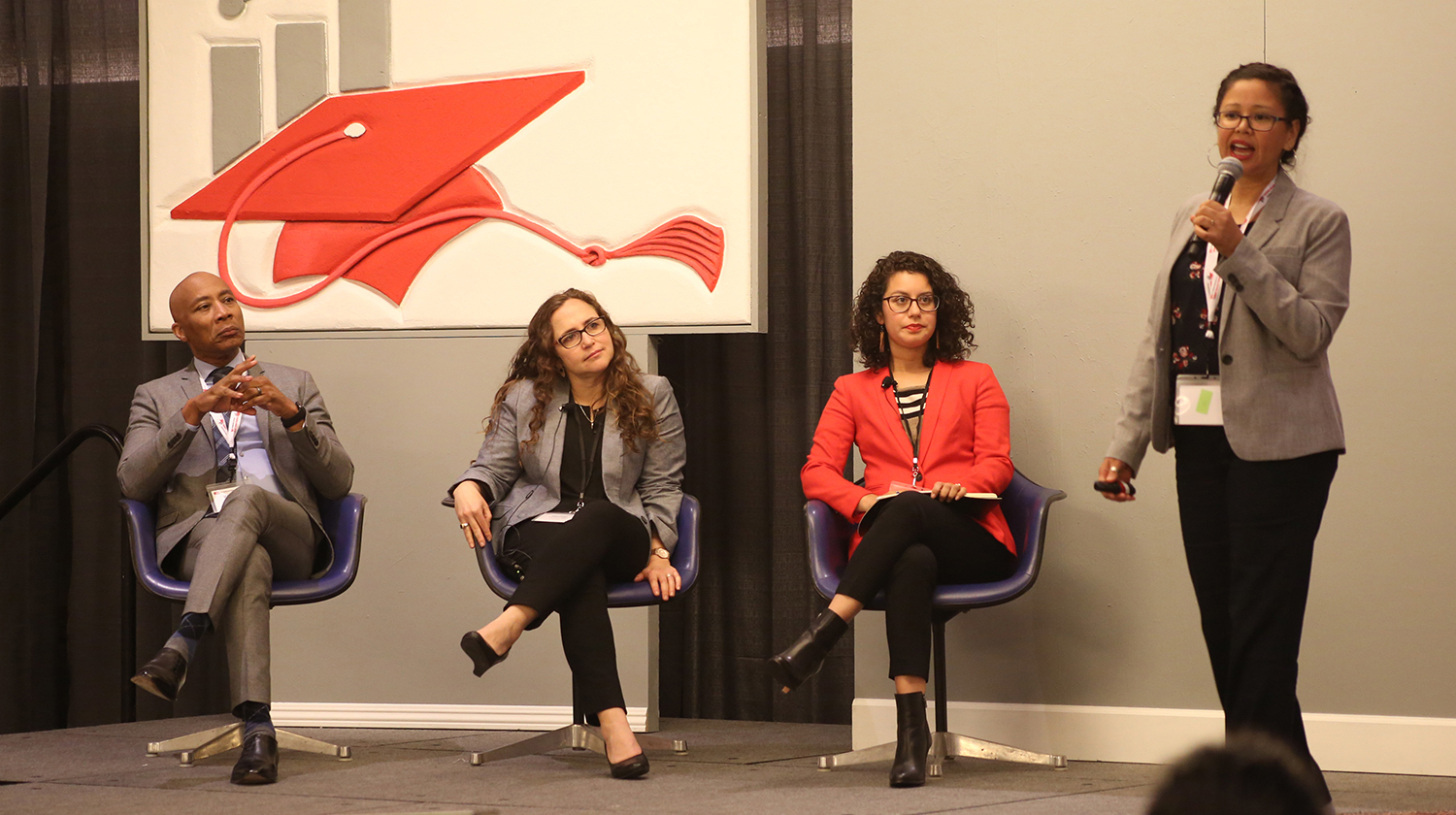
Source: Inside Higher Ed
Skip to the Q&A with Norma Quintero below.
Things are heating up. I encourage everyone to get out and grab some sunshine (with a mask on, of course).
Before we get to it, some fun things to cleanse your palate.
The Washington Post‘s TikTok guy, Dave Jorgenson, sat down with Rainn Wilson (aka Dwight from The Office) to talk about anxiety and breathing techniques. It’s a strangely calming interview to watch.
I found some nice wildlife shots for you.
And yes, there is yet more UFO news.
Before we move on, this is a gentle reminder that you’ll find our weekly Q&A if you scroll down. Last week, I talked with a university psychologist about what the switch to remote everything has meant for her work and her students’ mental health.
Now let’s get to the news.
The ”‹National Association of Student Financial Aid Administrators conducted a survey that found many colleges were confused by guidance from the Education Department on how to disburse emergency aid provided through the CARES Act to students. Many said the guidance released April 21 delayed their disbursement of the funds to students.
Sixteen subcontracted workers at Appalachian State University have tested positive for COVID-19. University leaders say those affiliated with the institution are not at risk.
The University of Akron is eliminating three sports: men’s cross country, men’s golf and women’s tennis. The athletic department’s budget is being cut by nearly 25 percent.
A popular work permit that lets international students in Canada work in the country for three years postgraduation will now accept time spent attending courses online due to the pandemic.
Here’s a quick roundup of our latest stories, in case you’ve fallen a bit behind (we don’t blame you):
In a talk with Vice President Pence, leaders at 14 colleges said they’d be less hesitant to reopen campuses if there was some assurance they would be protected from lawsuits, Kery Murakami reports.
Kery also has a story on state budget cuts and how they just keep getting worse and worse.
Remember when Wells College said it would have to close if it can’t reopen its campus in the fall? Emma Whitford spoke with the college’s president about its stark reality.
Marjorie Valbrun wrote about how educators are dealing with the loss of colleagues during the pandemic.
News From Elsewhere
Open-access publishing may be getting a boost from the pandemic, Times Higher Education reports.
A new website compiles resources, experts and information on what happens when colleges close.
The Chronicle of Higher Education wrote about a department chair whose daily emails to staff provided a glimpse into the full force of the pandemic.
Percolating Thoughts
This is a time when everyone has an opinion. As journalists, we try not to have opinions, but we’ve gathered some interesting ones from others.
The president of Paul Quinn College wrote a blisteringly blunt piece in The Atlantic about why colleges shouldn’t be reopening.
A security expert and former police commissioner makes the case for reforming the Clery Act.
The president of Lasell University says higher education needs to save itself in a piece for Education Dive.
Q&A with Clinical Psychologist Norma Quintero
Thanks for sticking around. Below is our Q&A for this week. I spoke with Norma Quintero, a clinical psychologist at California State University, Dominguez Hills, about how her work has changed due to the coronavirus pandemic and how people can support their own mental health during this time.
Q: How long have you worked at Dominguez Hills?
A: I’ve been going on five years now. I started as a doctoral intern, and they kept me on.
Q: How was the switch to remote services for you?
A: The transition was difficult, because we were clinic-based. So students on campus just would walk into the clinic if they needed services, or they would schedule an appointment to begin treatment. All of our assessments were in person; all of our treatment was in person. There was very limited phone contact. So, transitioning to telehealth was a challenge, and it continues to be a challenge in different ways.
The first is the technical. Because we were clinic-based, our charts were in the clinic. Even though we have an electronic system, our charts were still in the clinic. In order to serve our students, we need to have their charts. So we had to, or the IT department had to, create a remote desktop link so that we could access our desktops remotely. That took a while. For me, particularly, it was a pain because I had a really old phone and was having all sorts of technical difficulties. I became very anxious, because I’m now off-campus, I have students that I’m working with, I’m worried about them, I’m worried about how can I get this stuff.
We were off for a week and then we went back to the clinic, just the counselors, to devise a plan of how we would potentially transition. The transition process was very painful in some ways. Once we recognized what we were going to do, we used Zoom. We were also looking at confidentiality, because it’s confidential information, so what’s the best way to serve our students and still try to make it as confidential as possible? We know we’re using the internet and there’s flaws in that. We finally started to reach out to students. Some had already returned back to their homes.
A lot of our students are very low-income, so they live in small homes with a lot of relatives. Psychotherapy involves some sort of quiet, personal space where you can speak to someone about your life. Some of these students couldn’t continue with counseling because they didn’t have that privacy, which is another factor that’s adding stress. Because when they’re trying to do remote learning, they just don’t have the privacy. They have little siblings or parents or tías [aunts] or uncles — there’s just a lot of people.
It’s been absolute challenge. The day-to-day stress and anxiety, that’s worked out OK with telehealth. We’ve been doing it now for about month and a half. The big challenge, for me, is crises. When we have students in crises, I feel very ill equipped working from home. At least in my office, I have psychiatrists, I have coworkers I can consult with and I have my director. And I still have them — I can pick up the phone and call them. But it’s isolating and different.
People in private practice, this is probably their norm. But I’m a community psychologist. I love being in the community; I love being with the students. For me, it’s a bit of a challenge. But I’m acclimating.
Q: Are there any other challenges you’re facing?
A: I don’t think we’re seeing everyone. I do feel that, because students are not on campus, they might forget that we are here to support them. We keep trying to remind them through social media, like, we’re here, come see us, give us a call so we can start treatment. But I think because we’re off-campus it’s a little bit remote in their minds.
Not having a community is a challenge. Not having a team of experts or a team of psychologists to connect with on cases. I think we’re making more decisions on our own without consulting as much, and I think that can be a challenge.
With the students, I feel like students with whom you’ve already worked, they’re easier to transition to telehealth than those who haven’t done counseling. For students who have never attended counseling, it can be a very anxiety-inducing process. There might be a stigma to accepting that one needs counseling. I think it might be a little bit more challenging for students to seek us through telehealth.
Q: Have there been any positives from this?
A: I feel that, because we were relegated to our homes, a lot of what we avoid when we [are distracted] and are rushing around has come to the surface. The counseling itself has been very rich in helping students identify things that maybe they want to run away from or avoid or ignore. So in terms of the work itself, it’s been very good to see students slow down and deal with their sadness or their anxieties or their loneliness or their existential crises.
I’ve heard a lot of our students say they work while they attend school, so they don’t spend a lot of time with family because they’re so busy. So some have enjoyed that, getting to spend more time with relatives. For other students it’s been more difficult because there’s been more tension at home. Also, there has been a lot of financial disruption. Maybe parents have lost their jobs or they’re unemployed, so tensions are higher.
We have undocumented students on campus, and they’re struggling with losing their jobs and then not being eligible for unemployment benefits. Also, some of their families are not eligible for the stimulus checks. We have mixed-status households, so that support isn’t coming their way.
There’s an upcoming Supreme Court decision in June with the potential to end [the Deferred Action for Childhood Arrivals program], and that’s raising that level of anxiety among those students. So it’s different stressors affecting the community. I think it’s a little harder for us to offer that support when we’re remote.
The other thing that has seemed to be beneficial is some of my students are exercising more, for example. Some of my students are taking up crafts like knitting or sewing or gardening. Some are cooking a bit more. Some are getting acclimated to the online classes. Those who have resources, they’re starting to get the hang of it.
Q: Has there been more interest in counseling services?
A: I’ve seen a reduction in new clients. In terms of existing students, they’ve kept up, except the ones who have gone back and have decided I’m going to pause on counseling until I’m back on campus, or I don’t have internet at home so I’m going to take a break. As a whole, there’s been a reduction. This would not be the case if we were on campus. If we were on campus, we would have a wait list, probably.
Q: What are you hearing from students — what are the biggest issues for them right now?
A: There’s a lot of fear, there’s a lot of anxiety.
Our graduating seniors are very sad that they’re not going to have their ceremonies and very worried about work. I have a couple of seniors who are very concerned about, where am I going to work when this is all done, because who is hiring at this time? There’s a lot of uncertainty, a lot of anxiety around that.
And sadness. Sadness around not being able to celebrate this big accomplishment with family. As of now, I hear that they’re delayed or postponed. I really don’t know what that means for ceremonies. We just got word that we are going to be online through the fall, so that’s going to be a big adjustment for students.
Unfortunately, I think we’re going to see a drop in enrollment next semester. For some students, it’s just incredibly difficult and challenging, one financially, and two, for some students it doesn’t make sense to enroll in school if it’s not a way that they’re learning. Being at home is not the same as being at school; it’s just a different motivation. The motivation level, I think, has dropped for some students. The longer we stay remote, the more difficult it is to engage our students.
Q: How do you think the pandemic will affect students’ mental health in the long term?
A: I think that’s hard to know. I think that there will be consequences. In terms of social relationships, for example, they’ve changed. The nature of relationships has changed because we’re being asked to be physically distant. So people are spending a bit more time in their homes again or in the unit that they have, so some of those friendships are straining, some of those romantic relationships are straining.
The people who are socially anxious — they’re very comfortable right now, because they’re home, they’re in their safe space. They don’t have to deal with that anxiety in a social setting, they don’t have to break out of that shell and connect and interact with people. So I do feel that the levels of social anxiety will rise when we are allowed to socialize again, among people who do struggle. As a society, I think we will continue with anxiety, because there are a lot of unknowns.
It’s hard to know in what ways people will be affected. When you are heightened for a chronic period of time, that has an impact on you, mentally and physically. I foresee something, but I can’t say exactly what.
Q: Do you worry about possible cuts to counseling services in the future?
A: Other universities have already furloughed their staff, so that is of course a fear. It’s difficult to know, because it’s taking such a hit on the economy, and we work for the state public system. I would hope that we don’t.
Because I do think that, when we return physically on campus, we’re going to be extremely busy. It will be a huge readjustment for students, and that always brings up anxiety and fear because there has been a major break in their routine. We’ve been busy; it slowed down a bit, but we’re all still seeing students.
I hope there aren’t any cuts, because we’re going to need more psychologists. We already did before we went remote. So when we are physically back, we will need additional support. So I hope not. I hope the university and the CSU system recognize that mental health is essential and that they don’t cut us.
Q: As a mental health professional, what is one thing you would like to tell people about how to weather this pandemic in a healthy way?
A: Creating a routine is important. From the beginning I would tell my students: get out of bed, shower, change out of your clothes, and then if you have enough space and there’s a table you can go to or a desk somewhere, go plant yourself there and work. It’s almost like you have to create separation between home and work.
The second thing is exercise is really essential, whatever that looks like. Whether it’s yoga, whether it’s — one of my coworkers sent me an African dance class that I do at home. I try to go for walks whenever I get any breaks. Some level of exercise is healthy for the mind, and it’s healthy for the body. I think the fitter you are, the better you are able to face any kind of illness.
I think any craft or reading or anything that slows the mind. I recommend students try to limit their screen time, whether that’s TV or video games or laptops or phones, and allow their mind to just naturally slow itself down, because distractions don’t help us do that. So gardening or cooking or baking, or anything that people can start to do.
I think also just remembering to take it all in stride, one day at a time. It is a time of a lot of emotions, a lot of mixed emotions. Just welcoming them and having an attitude of acceptance and compassion towards yourself with whatever is coming up.
Q: Is there anything else you’d like to add?
A: I think it’s important for society at large to have sympathy for students. It’s been difficult for students who have not chosen online courses to suddenly get thrown into an online scenario. I think sometimes parents, especially parents of first-generation students, they struggle to understand what education looks like. So it’s easy for them to ask the kids to take care of younger siblings or do their chores while a student is attending class online.
It’s good for all of us to have some empathy toward their struggles. They’re going through their college education in a very different way.


